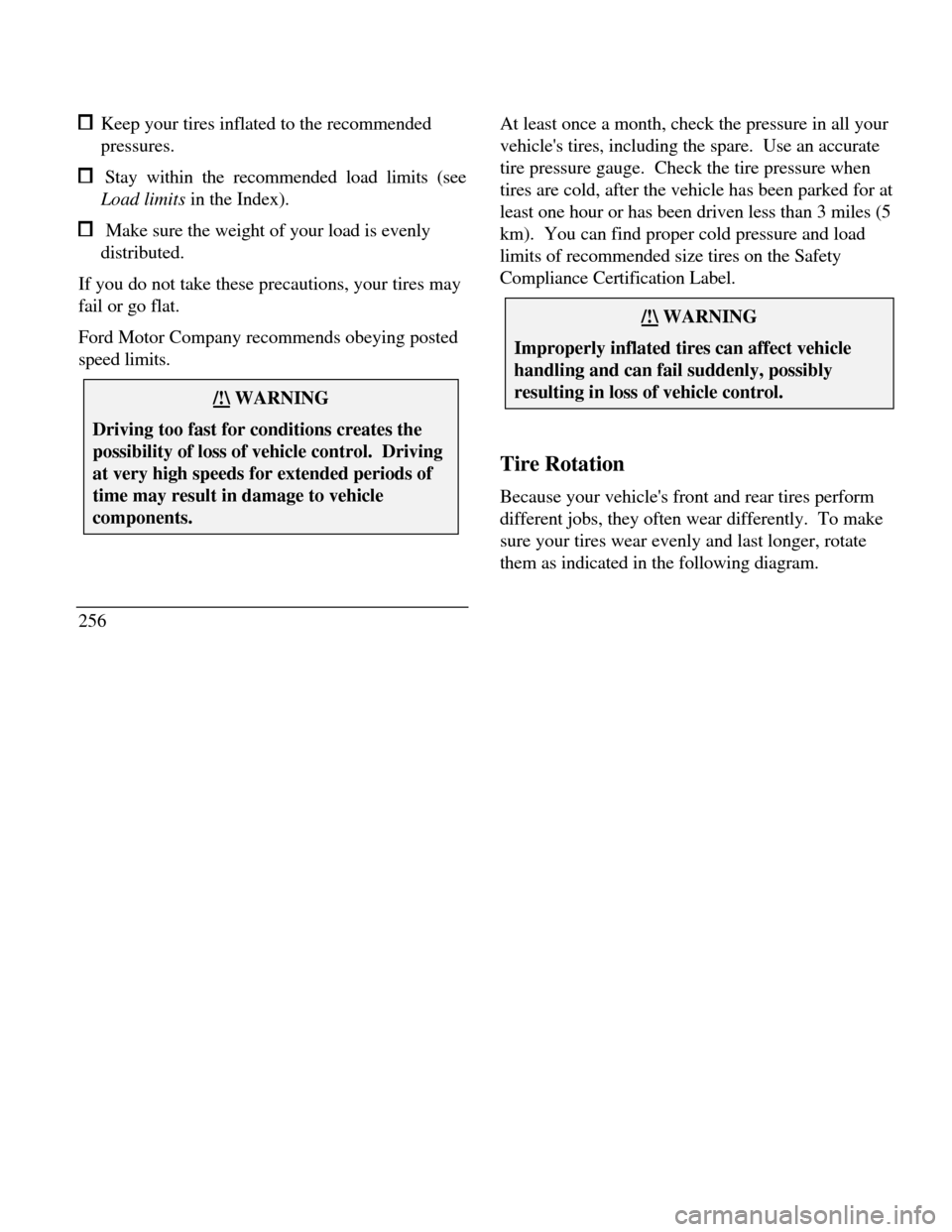Page 246 of 320

Using speed control in hilly terrain Extended use of the A/C, defroster, rear window
defroster and other accessories Underinflated tires Heavy loads Aftermarket add-ons such as bike, ski or luggage
racks, bug deflectors, etc.
Self-Service Pointers
If you choose to do your own fueling, you should
also perform a few simple maintenance routines.
This extra effort will save you additional money and
contribute to the driving efficiency of your vehicle.
The following procedures require only a tire gauge,
a rag, an oil can spout and windshield washer fluid.Check the engine oil at every refueling stopClean the windshield, outside mirrors and
headlights
244 Check windshield washer fluid Check tires for excessive wear or worn edges Check the tire pressure at least monthly
Engine Oil Recommendations
We recommend using Motorcraft oil or an equivalent
oil meeting Ford Specification ESE-M2C153-E and
displaying the American Petroleum Institute
CERTIFICATION MARK on the front of the
container.
Page 250 of 320

Your vehicle's coolant protects your engine from
overheating in the summer and from freezing in the
winter. Check the level of the coolant at least once
a month. Simply look at the engine coolant
reservoir located in the engine compartment. To
locate the reservoir, see the diagram of your
vehicle's engine under Engine Type, in this chapter.
Check the engine coolant level in the engine coolant
reservoir at least once a month using the following
guidelines.
When your vehicle's engine is cool, the coolant level
in the engine coolant reservoir should be at the top
of the clear portion of the reservoir. If the level is
below the cold fill level, coolant may need to be
added.
The coolant additives also protect the entire cooling
system from internal passageway corrosion and
these additives lubricate the water pump. The
coolant should be serviced as noted in the
Maintenance Schedule and Record booklet.
248Adding engine coolant/!\ WARNINGDo not put engine coolant in the containerfor the windshield washer fluid.If sprayed to clean the glass, engine coolant or
antifreeze could make it difficult to see through the
windshield./!\ WARNINGNever remove the pressure cap while theengine is running or hot. Follow these stepsto avoid personal injury that can be causedby escaping steam or engine coolant.1. Before you remove the cap, turn the engine off
and let it cool. Even when the engine is cool, be
careful when you remove the pressure cap.
Page 253 of 320

Engine coolant drain and flush
Proper procedures for a complete coolant drain and
flush of the cooling system can be found in the Car
Service Manual. Following these recommended
procedures will ensure that the specified coolant
level and a 50/50 or appropriate mixture of coolant
and water is maintained.
Engine coolant refill procedure
When the entire cooling system is drained and
refilled, the following procedure should be used to
ensure a complete fill:
NOTE: It is imperative the following procedure
be adhered to. Failure to do so could result in
damage to your engine. Remove coolant reservoir pressure cap. Remove the engine coolant outlet tube fill plug
on the engine. With the engine off and cool, add a 50/50 mixture
of recommended cooling system fluid and water
to the coolant outlet tube fill neck until the
reservoir is full.
NOTE: DO NOT FILL COOLANT SYSTEM
THROUGH COOLANT RESERVOIR. COOLANT
WILL NOT ENTER ENGINE, WHICH CAN
LEAD TO ENGINE DAMAGE.
NOTE: Avoid spilling coolant on the front end
accessory drive belt, as this will allow the belt to slip
and become noisy. Reinstall the pressure cap to the coolant
reservoir. Continue filling at the engine coolant tube fill
neck slowly while allowing air to escape. Reinstall the engine coolant tube fill plug when
the system is full.
251
Page 257 of 320
![LINCOLN CONTINENTAL 1996 Customer Assistance Guide (temperatures below 32°F [0°C]). State or local
regulations on Volatile Organic Compounds
(VOCs) may restrict use of the most common
antifreeze, methanol. Washer fluids containing non-
methanol a LINCOLN CONTINENTAL 1996 Customer Assistance Guide (temperatures below 32°F [0°C]). State or local
regulations on Volatile Organic Compounds
(VOCs) may restrict use of the most common
antifreeze, methanol. Washer fluids containing non-
methanol a](/manual-img/15/6872/w960_6872-256.png)
(temperatures below 32°F [0°C]). State or local
regulations on Volatile Organic Compounds
(VOC's) may restrict use of the most common
antifreeze, methanol. Washer fluids containing non-
methanol antifreeze agents should be used only if
they provide cold weather protection without
damaging the vehicle's paint finish, wiper blades,
and windshield washer system.
Wiper Blades
Check the windshield wiper blades at least twice a
year. Also check them whenever they seem less
effective than usual. Substances such as tree sap
and some hot wax treatments used by commercial
car washes reduce the effectiveness of wiper blades.
If the blades do not wipe properly, clean both the
windshield and the wiper blades. Use undiluted
windshield washer solution or a mild detergent.
Rinse thoroughly with clear water. Do not use fuel,
kerosene, paint thinner, or other solvents to clean
your wiper blades. These will damage your blades.To make reaching the wiper blades easy, simply turn
the ignition to the ACC position and turn your
wipers on. Wait for them to reach a vertical position
and turn the ignition to the OFF position. Do not
move the wipers manually. Manually moving the
wipers across the windshield may damage them.
Wiper blade replacement
If the wiper blades still do not work properly after
you clean them, you may need to replace the wiper
blade assembly or the blade element. When replacing
the wiper blade assembly, blade refill, or wiper arm
always use a Motorcraft part or equivalent. To
replace the blades, follow the instructions that come
with them.
Tires
Look at your tires each time you fill your fuel tank.
If one tire looks lower than the others, check the
pressure in all of them. Always follow these
precautions:
255
Page 258 of 320

Keep your tires inflated to the recommended
pressures. Stay within the recommended load limits (see
Load limits in the Index). Make sure the weight of your load is evenly
distributed.
If you do not take these precautions, your tires may
fail or go flat.
Ford Motor Company recommends obeying posted
speed limits./!\ WARNINGDriving too fast for conditions creates thepossibility of loss of vehicle control. Drivingat very high speeds for extended periods oftime may result in damage to vehiclecomponents.256At least once a month, check the pressure in all your
vehicle's tires, including the spare. Use an accurate
tire pressure gauge. Check the tire pressure when
tires are cold, after the vehicle has been parked for at
least one hour or has been driven less than 3 miles (5
km). You can find proper cold pressure and load
limits of recommended size tires on the Safety
Compliance Certification Label./!\ WARNINGImproperly inflated tires can affect vehiclehandling and can fail suddenly, possiblyresulting in loss of vehicle control.Tire Rotation
Because your vehicle's front and rear tires perform
different jobs, they often wear differently. To make
sure your tires wear evenly and last longer, rotate
them as indicated in the following diagram.
Page 260 of 320

/!\ WARNINGWhen replacing full size tires, never mixradial, bias-belted, or bias-type tires. Use onlythe tire sizes that are listed on the tirepressure decal. Make sure that all tires arethe same size, speed rating, and load-carryingcapacity. Use only the tire combinationsrecommended on the decal. If you do notfollow these precautions, your vehicle may notdrive properly and safely.Tires that are larger or smaller than your vehicle's
original tires may also affect the accuracy of your
speedometer.
258Information About Tire Quality Grades
New vehicles are fitted with tires that have their Tire
Quality Grade (described below) molded into the
tire's sidewall. These Tire Quality Grades are
determined by standards that the United States
Department of Transportation has set.
Tire Quality Grades apply to new pneumatic tires for
use on passenger cars. They do not apply to deep
tread, winter-type snow tires, space-saver or
temporary use spare tires, tires with nominal rim
diameters of 10 to 12 inches or limited production
tires as defined in Title 49 Code of Federal
Regulations Part 575.104(c)(2).
U.S. Department of Transportation - Tire quality
grades: The U.S. Department of Transportation
requires Ford to give you the following information
about tire grades exactly as the government has
written it.
Page 262 of 320

loading, either separately or in combination, can
cause heat buildup and possible tire failure.
Snow tires
The tires on your vehicle have all-weather treads
that provide traction in rain or snow. However,
during the winter months in some climates, you may
need to use snow tires.
Use of tire chains is not recommended. The use of
tire chains could result in damage to your vehicle./!\ WARNINGSnow tires must be the same size and gradeas the tires you Currently have on yourvehicle.Cleaning the Wheels
Wash the wheels with the same detergent you use
to wash your vehicle's body. Do not use acid-based
wheel cleaners, steel wool, abrasives, fuel, or strong
260detergents. These substances will damage protective
coatings. Use tar and road oil remover to remove
grease and tar.
NOTE: Before going to a car wash, find out if the
brushes are abrasive.
If you have whitewall tires that are difficult to clean
with regular detergent, use whitewall tire cleaner.
Follow the directions on the container and rinse the
tires with plenty of clean water.
Securitires (If equipped)
Securitires are designed to allow you to continue
driving your Continental a limited number of miles
when one of your vehicle's tires is at low or even
zero air pressure./!\ WARNINGDo not use aerosol tire inflator/sealer withSecuritires. Doing so may damage the tire'spressure sensor.
Page 294 of 320
Battery Check and recharge as necessary. Keep connections clean and covered with a light
coat of grease. If storing your vehicle for more than 30 days
without recharging the battery, disconnect the
battery cables to ensure battery charge is
maintained for quick starting. NOTE: If battery
cables are disconnected, it will be necessary to
reset any memory features (eg. radio presets).
Brakes Make sure brakes and parking brake are fully
released.
292Tires Maintain recommended air pressures.
Miscellaneous Make sure all linkages, cables, levers and
clevis pins under vehicle are covered with grease to
prevent rust. Move vehicles at least 25 feet (8 m) every 15
days to lubricate working parts and prevent
corrosion.